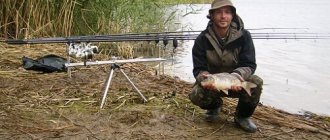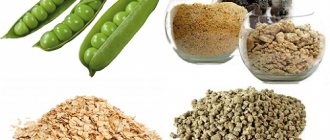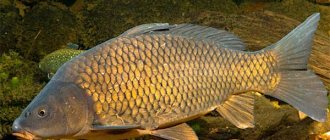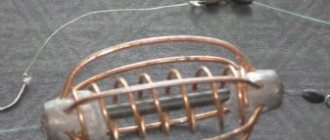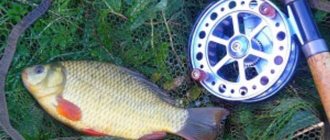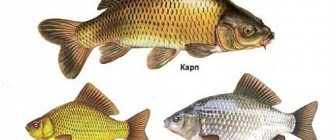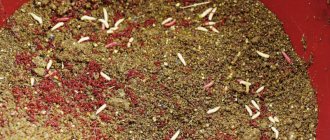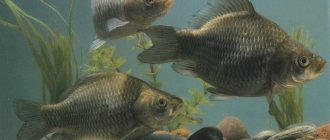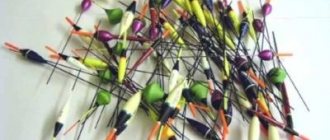Features of breeding carp at home
Carp (or common carp) lives in fresh water bodies and rivers located in a zone with a temperate climate. In addition, fish are often bred in summer cottages, setting up an artificial pond or pool for them. Carp is unpretentious to its conditions and can eat a variety of foods, but for normal growth, certain rules must be followed when growing it. The main recommendations for breeding this fish, a description of the characteristics of its spawning and feeding, are further in the article.
Features of carp spawning
Carp begins to spawn in the spring after stable warm weather has established. This process takes place once a year and usually falls in the second half of May, ending around mid-June. After spawning, the process of formation and gestation of reproductive products in sexually mature individuals lasts for a year.
Main features of spawning:
- carp reaches sexual maturity at the age of 3–4 years;
- first, small individuals spawn, and then larger ones;
- during spawning, the water temperature should be at least +18°C;
- the female releases eggs in stages over several days, but the first portion is the largest;
- after laying eggs, males immediately fertilize them with milk, distributing it over a radius of several meters;
- when cold weather sets in, spawning stops and the fish wait for favorable conditions to arise;
- the most active spawning and fertilization occurs from dawn to noon;
- females prefer to lay eggs in shallow water, choosing the same places for this;
- spawned individuals lie down to rest for 5–7 days, becoming inactive, and then restore strength with increased nutrition.
When breeding carp at home, it is recommended to transplant them into a separate pond during spawning.
In this case, for each female there should be 1–2 males. A layer of moss or turf is placed at the bottom of the reservoir - this is where the fish will spawn. About a week after fertilization, the eggs hatch and the young hatch. To prevent the fry from being eaten by the adults, the latter are transplanted back into the main body of water. Young offspring should grow up in a separate pond.
What does it eat?
Competent fishermen know: before going fishing, you need to find out what the prey eats. This knowledge helps to select the right baits and complementary foods to which the species will respond better than other inhabitants of the reservoir. There are fish that are very picky about food, and there is carp - an omnivorous semi-predator, willingly rushing at almost any thrown treat.
The main increase in the mass of common carp occurs in the first 5-7 years of life. Therefore, young animals spend almost the entire warm season in places with an extensive food supply. Depending on their age, individuals choose what to eat:
- Immediately after hatching, the fry eat microscopic insect larvae and fine-grained plankton, consisting of eggs and tiny crustaceans.
- Teenagers sink to the bottom, where they catch larger food: crustaceans, small bottom fish.
- Young fish older than six months do not hesitate to feast on other people’s eggs and their own, shed during the spawning period. Usually the “caviar” time coincides with the beginning of spring, when practically no other types of food can be found.
- At the peak of the warm season, carp eat young shoots from aquatic and coastal plants: reeds, egg capsules, cattails. Then they allow themselves to eat leeches, snails, worms, and zebra mussels.
The body of the common carp has a very specific structure - it does not have a stomach. In order not to die from exhaustion and constantly maintain weight, he needs to continuously eat. That’s why experienced fishermen know: if a carp doesn’t bite, it means it simply doesn’t live here.
Growing carp at home
If you wish, you can independently breed carp at home, growing it in an artificial reservoir. This process is quite simple, since the fish grows quickly and is unpretentious to the conditions of detention and the composition of the feed. But before purchasing fry, you need to prepare a place for raising them and purchase the necessary equipment.
Selecting a location
To obtain the desired result, first of all, you need to correctly select and prepare a place for growing fish.
Basic requirements for the placement of a reservoir:
- one part should be in the sun, and the second in the shade - carp is thermophilic, so the water should warm up well, but in extreme heat the fish will be more comfortable in the shade;
- the place should be away from sources of noise - loud extraneous sounds will frighten the fish;
- The reservoir cannot be built in a low-lying area - in this case, during rains, dirty water will flow into it.
In private fish farms, an artificial pond is usually used for breeding carp. In order for the fish to grow normally in it and not suffer from diseases, you need to follow some recommendations. Preparing such a reservoir usually takes about one year.
Basic requirements for arranging an artificial pond:
- the depth of the reservoir can be from 1.5 to 3 m - if this parameter is greater, then the sun will not be able to warm up the water column well;
- fish need a sufficient amount of free space, so the length and width of the pond should be about 3 m;
- To prevent the soil from the shore from sliding into the water, it needs to be strengthened - for this, trees and shrubs are planted near the reservoir;
- before pouring water, you need to compact the bottom of the pond - it is covered with sand and filled with liquid concrete mixture, and when the latter dries, a rubber film is pulled on top;
- to create a natural microclimate, 20–30 liters of water from a wild lake or river are poured into an artificial reservoir - it contains the necessary microorganisms;
- you can additionally sow the bottom of the pond with algae - they contribute to the creation of natural microflora and also serve as food for carp;
- Before adding fish, the water in the reservoir must settle and warm up to a temperature of +24°C.
Pool
You can also grow carp on your property in a specially equipped pool. In such a reservoir it is easier to monitor the cleanliness and temperature of the water, and there is also the opportunity to observe the behavior of the fish.
Basic rules for preparing a pool:
- you can dig such a reservoir in the ground or use ready-made store-bought structures made of plastic or polypropylene;
- the depth of the pool should be about 1.5 m so that the water is well heated by the sun;
- the reservoir can be round or square in shape, and its width should be 2–3 m so that the fish have enough free space;
- for the convenience of changing water, a drainage system is installed - a hole is placed at the bottom of the structure, connecting to it a tube with a plug at the end leading to the sewer;
- to create natural microflora, several buckets of water from a wild fresh lake or river are added to the reservoir;
- the filled pool is left to settle for several days to warm the water and multiply the necessary microorganisms.
Video: Construction of a pool for growing carp
Breeding equipment
When breeding carp in an artificial reservoir, it is recommended to use additional equipment that will make caring for the fish easier.
The list of such devices includes:
- fish cages ;
- filters on the water supply and drainage pipes do not allow carp to slip into the holes;
- compressor or aeration system - needed to enrich water with oxygen;
- automatic feeders - allow you to give food to the carp several times a day at certain intervals;
- oximeter - determines the level of oxygen in water;
- pumps - make it easier to pump water into a reservoir;
- incubators - provide ideal conditions for the successful hatching of fry from fertilized eggs;
- thermometers - allow you to determine the temperature of the water;
- equipment for artificial heating - used when wintering fish in the open air, allowing you to maintain a comfortable temperature in a pond or pool;
- bottom cleaners - help keep the reservoir clean without frequent water changes;
- sterilizer - kills harmful microflora;
- devices for checking the composition of water - allow you to monitor the degree of contamination of the reservoir and clean it in a timely manner.
Requirements for a pond for growing carp
Are you thinking about where to raise fish? For beginners, you can use an artificial pond. And now we will look at what this artificial pond should be like.
Since carp are living beings, they require certain conditions for their life, namely: the optimal amount of oxygen in the pond is not lower than 6-8 mg/l, because fish cannot breathe pure oxygen, and from a decrease in the level of oxygen in the water, carp can die from suffocation; and one more thing - the optimal depth of the pond is 1.8-2 m.
Undoubtedly, an important point that needs to be taken into account when breeding carp is the temperature regime. The growth of fish during the ripening period largely depends on this indicator. The most favorable temperature is 18–20 degrees. In summer it can increase to 22–29 degrees. At this temperature, the carp makes full use of the food and, accordingly, grows well.
Suitable conditions of detention
Common carp is an unpretentious fish, but it grows and reproduces best when certain conditions are created in an artificial reservoir. First of all, heat-loving carp needs water at a comfortable temperature, which contains a sufficient amount of oxygen. In addition, you need to monitor the cleanliness of the reservoir, since its excessive pollution leads to the appearance of harmful microorganisms and fish diseases.
Temperature
For active growth of fish, it is necessary to maintain a certain temperature in the reservoir. In summer, carp are grown in a pond or pool outside. The optimal water temperature is +22…+24°C. In hot weather, an artificial pond can become very hot in the sun. But the water temperature should not exceed +30°C , otherwise the carp will eat poorly and grow slowly.
Special thermometers are used to measure water temperature.
Regulation of thermal processes in a reservoir is carried out by adding or draining water. For the winter, it is recommended to move carp to a large indoor aquarium. You can leave them to spend the winter in the open air only if the reservoir is equipped with an aeration system and it is constantly maintained at a positive temperature due to artificial heating of the water.
Water and its oxygen content
The ideal environment for growing carp in an artificial reservoir is an imitation of a small current and a sufficient level of oxygen. This effect can be achieved if you create a moderate movement of liquid in a pond or pool, and also use special devices to enrich it with air bubbles.
Basic requirements for water in a reservoir for growing carp:
- clean water is supplied from a river or well through a narrow pipe equipped with a pump;
- the dirty liquid is drained into the sewer - this procedure is carried out through a wide pipe with a filter located at the bottom of the pool or pond;
- the oxygen level in the reservoir must be at least 3 mg/l - this parameter is measured using an oximeter;
- In order to increase the number of air bubbles in the water, a compressor or a special oxygen generator is installed at the bottom of the pond or pool.
How to breed
After preparing the artificial reservoir, you can start breeding carp at home. To do this, young individuals are purchased and released into a prepared pond and pool. After performing these procedures, it is necessary to ensure that optimal conditions are maintained in the reservoir for the growth and development of fry, and also to know how much food the individuals require.
Purchase of fry
There are many varieties of carp that live in areas with different climate conditions. When buying young fish, it is recommended to take the type of fish that is suitable for cultivation in a particular region.
Basic rules for purchasing fry:
- It is recommended to purchase young fish from a specialized fish farm that has the necessary certificates and licenses;
- transportation of fish should be carried out in spacious tanks or buckets with fresh or rain water;
- fry for sale must be kept in a clean reservoir that meets all the listed requirements - otherwise there is a risk of buying sick and weak individuals;
- The optimal age of young animals is one year.
When to launch
In order for the fry to be comfortable in an artificial reservoir and not die, the water must warm up well to a temperature of +22...+24°C . Experienced fish farm owners recommend releasing carp into a pond or pool from late April to early May. The choice of a specific period for this procedure depends on the climatic conditions of the growing region.
If the reservoir remains cold by this time, then special equipment is used to heat the water. When growing carp in the southern regions, stocking is allowed in early autumn . But in this case, the fish may not have time to become sufficiently strong and grow before the onset of cold weather, so it is recommended to move it to a large indoor aquarium for the winter.
How and what to feed
In order for carp to demonstrate a rapid growth rate, it requires a balanced diet. The food must contain all the substances necessary for the fish and be supplied without interruption, in equal portions.
There are the following types of feeding carp:
- Extensive . Individuals independently find food in a well-equipped pond inhabited by natural flora and fauna (with the exception of other fish species). With this feeding, carp slowly gains weight, but its meat is an environmentally friendly product.
- Intense . The fish are given special food containing about 30–40% protein, which stimulates rapid growth and promotes weight gain. But at the same time, the taste characteristics of the meat deteriorate, and the reservoir is often polluted with food residues.
- Semi-intensive . It combines the first two types of feeding and is the most rational when growing carp at home. In this case, the fish partially feeds on its own, but also receives complementary foods.
When feeding carp, adhere to the following general recommendations:
- fish actively feed only in warm water;
- feed is poured in the morning and evening before sunset;
- the feeder is installed in a certain place in the reservoir and try not to move it;
- legumes and grains (wheat, beans, corn, oats, peas), earthworms, maggots, bloodworms, as well as ordinary rye bread are used as complementary foods;
- the food is poured in small portions - in this case, the carp will be able to completely eat it, and the leftover food will not pollute the water in the pond or pool;
- a single feed rate is approximately 3% of the weight of the fish;
- In order for the fish to develop normally and not get sick, special feed for chickens and pigs must be added to the diet, using it according to the instructions on the package.
How to breed fish in a pond? Growing technology
Fish can be grown either intensively or extensively.
- Extensive method - in this method the fish are not fed, they consume natural food. Fish grows with minimal investment.
- Intensive method - in this case, the fish are fed and, in addition, a rich food supply is created through the reclamation of the reservoir.
Several technologies for intensive cultivation of fish in a pond are known.
Traditional technology. It includes a 2 or 3 year growing cycle. This is how carp and other herbivores are bred. The main disadvantage of this method is its multi-stage nature. Each technological operation is carried out in a special pond. The completion of each stage is the release of water. In the process of implementing this technology, fish are transplanted several times: from nursery ponds to wintering ponds, from wintering ponds to feeding ponds. All these transplants are fraught with numerous losses. Another disadvantage of this method is the labor intensity of the processes. This method can only be effective if a number of requirements are met, namely: the water must be constantly running, it must be technically aerated, and the pond must be limed.
Continuous technology. It has recently enjoyed greater popularity than the one discussed in paragraph 1. This method involves raising young fish to a weight of 1 - 1.5 kg and further keeping the fish without transplanting for several years. In this case, you will need two ponds - a fry pond and a feeding pond.
Nutritional Features
In order for nutrition to be effective, it is necessary to know such factors as: the biological characteristics of a particular fish species, nutritional needs and the possibilities of their growth. The efficiency of nutrition directly depends on the environmental conditions in which the fish is located. Growth can be accelerated by feeding foods rich in proteins.
The energy needs of fish are relatively small. To gain 1 kg of body weight, food must contain at least 4500 kcal of energy. Fry have a great need for amino acids: arginine, leucine, lysine, valine, tryptophan, methionine, etc. If these amino acids are not enough in food, the fish may lose appetite, as a result of which growth rates will decrease. In addition, amino acid deficiency can lead to diseases.
Food should include fats of plant and animal origin. Their insufficient quantity will lead to the fact that the fish will stop growing, a disorder of physiological functions and tissue watering will occur, and irreparable changes in the liver may occur.
Food must contain fiber. For different types of fish its content is different. For salmon and trout, the smallest amount is required - 20%. In food for carp and catfish it should be at least 40%.
Fish food must necessarily contain biologically active substances. These can be premixes and enzyme preparations. Feeds of plant origin (cereals) are a source of carbohydrates and B vitamins. Bran should be included in fish feed mixtures.
A necessary component of a complete feed is animal feed. This is meat and bone and krill meal. For young animals, you need to use dairy products: skim milk powder and low-fat milk powder.
Possible diseases
The big risk in growing fish in a pond is its diseases, which can turn into epidemics. The condition of the fish must be monitored every 10 days. The most common diseases inherent in freshwater fish:
- aeromonosis (rubella). Symptoms: inflammation of the skin, dropsy, small areas of hemorrhage, bulging eyes;
- diseases of the gill apparatus (gill rot). The appearance of this disease is promoted by high water temperature and high content of organic substances in it. Symptoms: pale gill tissue, uneven death of its edges. The large fish stops eating and becomes inactive;
- discocotylosis is a disease of salmon and grayling fish. Young animals suffer the most from this disease. Symptoms: injuries to gill tissue;
- Ichthyophthyriasis is a typical disease for many species of fish. A characteristic sign is the presence of white bumps on the body;
- Fish dactylogyrosis - this disease is characteristic of pond fish. The disease becomes more active in the summer. It is mainly the fry that suffers. Symptoms: small individuals are not active enough, swim near the surface. The fish is very emaciated, the eyes are sunken, and anemia of the gills is visible.
Business for gardeners: growing strawberries at home for sale.
Crisis option: we launch our own production of cheese products.
What is the maximum size it grows to?
Carp lives for about 30 years, and some individuals can reach the age of 40 years. The rate of weight gain depends on the growing conditions of the fish and the regularity of its feeding. An adult can weigh more than 25 kg, with a maximum length of 1.2 m. At home, carp are usually grown to a size of 40–45 cm.
The approximate relationship between the weight of an individual and its length is presented in the table:
Carp fish-farming.ru
Carp is the wild predecessor of domestic carp. One of the most widely distributed fish species. Currently, the carp and its cultural form, the carp, are spread by humans throughout the globe. In addition to Europe and Asia, it is found in North America, Australia, Africa and on the islands of oceanic archipelagos. It has a wide, thick body covered with large, dense, golden scales. The base of each scale has a black spot, and along the edges it is bordered by a dark stripe. The dorsal and anal fins each have one hard, serrated ray. The first bony ray of the dorsal fin is located slightly closer to the tail than the ventral fins. It has a pair of antennae in the corners of the mouth and on the upper lip. The lower mouth can extend into a tube. With its help, the carp finds in the mud and eats bloodworms - the larvae of pusher mosquitoes, its favorite food - at a depth of up to 12 cm. In general, the carp is omnivorous, it can consume both animal and plant foods: mollusks, insect larvae, worms, crustaceans, plant seeds, grain feed, table waste, compound feed. This is facilitated by the large length of the intestine, 1.5-2 times the length of the body.
Carp, like all carp fish, does not have teeth on its jaws. However, it has three rows of projections on the pharyngeal bones called pharyngeal teeth. In addition, on the lower process of the occipital bone it has a horn-like cushion-like protrusion called a millstone. With the help of pharyngeal teeth and a millstone, the carp is able to grind even the coarsest plant foods, which, when crushed, are better digested by the intestines. Carp, like all other carp, does not have a stomach. Therefore, unlike, say, most predators, he is forced to eat little and often. This should be taken into account when organizing artificial feeding of carp.
Carp is a large, fast-growing fish, reaching a weight of 20 kilograms or more. Its maximum reliably established weight is 45 kg. Such a specimen was caught at the beginning of the century near Taganrog. The growth rate depends mainly on water temperature and food supply. Under favorable conditions, in the first year of life it can reach a mass of 300 g, in the second - 1 kg or more. The highest feeding intensity and growth rate are observed at a water temperature of 25–29 °C. At water temperatures below 8-10 °C, it practically stops feeding. Carp meat has an exceptional taste. It is no coincidence that Astrakhan fishermen, who know a lot about fish and have a wide choice of different types of fish, including sturgeon, most often prefer carp to prepare real fish soup. It is unpretentious and can grow well in both fresh and brackish water. Withstands a short-term decrease in the concentration of oxygen dissolved in water to 1 mg/l, winters well in ponds and is resistant to most diseases found in carp. Reaches sexual maturity at the age of 3 - 6 years, depending on the climate zone.
Males mature one year earlier. The differences between males and females are small. They can be distinguished only before spawning, when the males develop their nuptial plumage. At this time, the gill covers, as well as their scales, are rough to the touch. Female carp are larger than males of the same age. Fecundity is high, depending on the weight of the female and living conditions. In large individuals it ranges from 500 thousand to 1.8 million eggs. Spawning begins at a water temperature of 13–15 °C, but occurs most intensively at a temperature of 18–20 °C.
Females lay eggs on freshly watered vegetation, and males water it with milk. Fertilized eggs are sticky and stick to the plants. Spawning usually occurs in late spring, early summer. In the southern regions at the beginning of May, in the northern regions at the end of May and June. The hatching of larvae from eggs occurs 3-7 days after fertilization, depending on the water temperature. Adult fish do not care for their offspring.
Carp is a favorite object of amateur fishermen. It is caught well on worms, cake, peas, and specially prepared dumplings. Once hooked, the carp either tries to break the fishing line with acceleration, or saw it through with the jagged ray of the dorsal fin. Large carp is a strong fish, a worthy rival for any angler. High taste qualities, unpretentiousness to growing conditions, and rapid growth predetermined the choice of carp as the main object of artificial breeding many centuries ago. On its basis, a domesticated form of carp, carp, was created.
Carp farming first appeared in China and independently in Europe. The original form of domestic European carp was the Danube carp. Domesticated form of carp. Despite the fact that both carp and carp belong to the same species and all their systematic characteristics are the same, there are some differences between them. They are due to the fact that carp is a form of carp, created to be grown in ponds in order to obtain the maximum possible amount of valuable meat. It is no coincidence that it is called pond carp.
Features of behavior
Features of the carp's lifestyle depend on the conditions in which the fish lives.
The reservoirs do not have a sufficient number of turf areas, which is why spawning individuals have to lay their eggs on hard vegetation and filamentous algae. Fish spawn in fresh water or in areas with low salinity; sea carp move to fresher areas. Spawning grounds are located in the coastal zone with a lot of vegetation. Adults arrive at the spawning grounds about a month before spawning. The water temperature does not exceed 10 degrees. Reproduction begins when the water warms up to 18-20 degrees.
Populations are capable of growing greatly; The number of carp in Australia, where they were introduced, is growing rapidly. Because of this, the local underwater fauna now consists of approximately 80% of this species, and other types of fish are being forced out of their natural habitat.
Fertilized eggs mature within 3-4 days, after which fry appear, feeding on insect larvae, and later on bottom crustaceans, mollusks, and worms living in the mud. Fish reach sexual maturity at 3-5 years. In males, the ability to reproduce appears when the body length increases to 29−36 cm. The female should grow to 34−45 cm.
Life expectancy is 30−35 years. At the same time, fish grow only up to 7-8 years.
In case of danger, it emits a special sound signal in the form of a series of crackling sounds.
During the winter it hibernates, lying down in deep holes. Breathing slows down, the fish stops feeding, and its body becomes covered with a thick layer of mucus. When the water temperature increases, it leaves the pits and becomes active again.
What does it eat?
There is a large amount of what carp eat: this breed is considered an omnivore. She eats both plant foods and animals. The diet varies depending on the season.
When water temperatures rise, the proportion of animal food in the diet increases. The carp begins to eat leeches, caddis flies, worms, and crustaceans.
In autumn, when the plants become too tough, this representative of the carp family stops eating them. Its menu consists of crustaceans, water striders, and beetles.
It is a type of stomachless fish, so it can feed without stopping.
Growing carp on a small farm
If desired, almost any good owner can successfully run a business of growing fish for himself and others with great efficiency. Ponds and backwaters of large and small rivers have a sufficient amount of food resources, have a favorable hydrochemical regime, and therefore there is a real opportunity to organize cage farms in them. Depending on the size of the reservoir, you can arrange from two to eight or more cages for the production of marketable fish.
For beginner fish farmers, we can recommend growing carp (carp, mirror, frame), because this species is not picky about environmental conditions and has high growth energy with appropriate feeding. The types and sizes of cages for growing commercial fish may be different, but the principle of their design is basically the same - they are rectangular “bags” made of nylon mesh hanging freely into the water, with a cell size of 6.5 or 10 millimeters. The cages are attached to a floating plank frame 30–40 mm thick. The board frame is fastened with metal squares: 45*45*5 mm, to which floats are attached (you can use empty metal barrels with a volume of 100 - 200 liters as floats). The optimal size for normal operation of the cage is 6*4*2.5 m (the height depends on the depth of the reservoir from 2 m to 3 m). After launching the cages into the water, they need to be stocked. For these purposes, a yearling carp weighing 25 grams is better suited; the planting density will be 200 pieces of planting material per 1 m2. When growing carp in cages, it is necessary to provide additional air supply to the cages. In addition, it is necessary to organize illumination of each cage in the water and above it to attract invertebrate aquatic microorganisms and night flying insects. Water aeration can be ensured by manufacturing and installing chamber-type air blowers directly on the cages (not difficult to manufacture, you can build it yourself), and using rechargeable batteries as a source of electricity. In order for the carp to quickly gain the required marketable weight, it must be provided with live food (housefly larvae) for the entire fattening period. To do this, you need to install six cultivators on the cage, alternately charging two cultivators. In this case, you can get up to 30 kg of fly larvae of different ages per cage per day. By eating the larva, the fish receives: 38% - lysine, 28% - methionine and cystitis, 31% - threonine; nutritional value: 55 – 60% protein, 16 – 18% fat, 8% BEV. During the period from May to October, using additional “live” feeding, carp can increase their marketable weight from 25 to 1000 grams. The success of growing commercial fish in cages is directly related to the influence of an external factor - the temperature of the habitat, which depends on weather conditions. It is also important to take care of the protection of farmed fish. More effective, but also more expensive, is the cultivation of marketable fish in pools, which can be recommended at later stages of development of fishing activities and if the farmer has some experience. This method of cultivation does not require the presence of ponds, lakes or rivers for fish farming. If there is sufficient water intake, swimming pools can be located both on a personal plot and in a vegetable garden or garden. The configurations and sizes of pools, like cages, can be different and made from different materials. They can be made of brick, building blocks, wood, concrete slabs, etc. The main condition is the tightness of the structure to retain water. It is necessary to provide the pool with: aeration of water with air; pumping fresh water; organize drainage of contaminants. The tightness of the pool can be achieved by using plastic film, gluing several pieces to the size of the pool, using an ordinary iron. Water pumping is carried out by a household electric pump. Aeration - as described above, or with any type of compressor. The optimal size of pools for a small farm is: 6*6*1.5 m and 6*10*1.5 m. Stocking in pools can be done in March - April by covering the pool in arches made of reinforcement or wood with film. It will be possible to catch fish from the covered pool for sale in December – January. During this period of time, the selling price of fish will be higher. Over 7,000 kilograms of marketable carp can be obtained from the pool during the growing period from March to December. The costs incurred for the manufacture of cages or pools are repaid in the spring – summer – autumn months. In addition to growing commercial fish in tanks, you can keep breeders with subsequent selection of eggs and incubation, as well as raise the larva, grow planting material (yearlings) and finally, buying live fish from commercial fish producers in the fall, keep it for 2-3 months and sell it in winter live prices. Cooperation between fish farmers can be another solution to organizing effective fish farming activities - one contains a queen cell, while collecting eggs, incubates and raises the larvae; – another is engaged in fattening the larvae until they are one year old; – the third, produces live food (rotifers, moina, daphnia, etc. for fattening the larvae); – the fourth produces commercial fish.
Pond fish farming, how to raise fish in ponds
Pond fish farming is the cultivation of commercial fish
in reservoirs specially adapted or built for this purpose. Pond farming can be complete (full-system) or incomplete (incomplete-system). In a full-system commercial farm, fish are raised from the egg stage to the market stage, and in a breeding farm, breeders are raised for fish hatcheries and full-system commercial farms.
In non-full-system farms, marketable fish are grown as planting material. They come in two types. The widest form of fish farming is feeding carp fish farming.
. In the spring, yearlings of carp weighing up to 30 grams are brought here from fish hatcheries, they are planted in feeding ponds, and in the fall marketable fish with an average weight of 500 to 800 grams are caught. Growing fish in a feeding farm is not difficult and is accessible to every farm.
The use of feed in carp farming
Cyprinids occupy a leading place in freshwater aquaculture (more than 70% of farmed freshwater fish belong to the cyprinid family). Carp can be grown either separately in monoculture or together with other species such as silver carp, grass carp and tench. Subject to certain conditions, cohabitation of carp and predators (catfish, pike perch and pike) is allowed. There are three carp breeding systems:
2. Semi-intensive (or semi-extensive);
The extensive system involves breeding carp without the use of fertilizing using natural food reserves available in the reservoir (zooplankton and bottom fauna). The advantage of this system is low production costs. The disadvantage is the low growth per unit area (from 300 to 700 kg). When using a semi-intensive system, the emphasis is on feeding fish with carbohydrate feeds (wheat, barley, corn, etc.), while providing the fish with protein components in the diet through natural (“live”) feeds, the availability of which is stimulated by various agrotechnical measures . The productivity of such a system varies from 700 to 1400 kg/ha. The semi-intensive system allows better use of available water areas. However, there are also disadvantages: the presence of “live” food, and, consequently, the protein part in the diet, which directly depends on the time of year and ambient temperature, which negatively affects the growth of carp. Therefore, it is necessary to feed carp with compound feed. When using feed in carp diets, the productivity per hectare of reservoir area can be doubled (from 2 to 3 tons per hectare). In addition, nitrogen and phosphorus released during the digestion of complex feed accelerate the development of natural food in the pond by maintaining a higher quality of the aquatic environment, since the compound feed is better absorbed by the fish, thereby reducing the amount of feces in the water. The result is a carp of great weight, distinguished by exceptional quality of meat. The result is good profits and stable production of fish products. Unlike the semi-intensive system, which is based on the use of natural feeds in carp diets, in the intensive system the basis is auxiliary complex feeds with a higher protein content (from 30% to 40%). Along with complex food, a higher density of planting of fish seeding material also implies additional aeration of the water in the carp pond or ensuring the flow of water through the pond. Productivity in earthen ponds with such a system ranges from 3 to 20 or more tons per hectare of water surface. The advantage of the system is the maximum use of the available water area for fish farming and high productivity per unit surface. The disadvantage is a greater risk of spreading diseases, as well as a decrease in the quality of water in the pond due to its contamination. As a separate type of intensive fish farming, we can distinguish a system of carp breeding in cage complexes (cage type). This breeding system is characterized by insignificant start-up investments in the manufacture of the necessary equipment (cages), high fish productivity per unit of water area and profitable production. As with the intensive system, the disadvantage is the easy spread of diseases and increased pollution of the reservoir, requiring additional protection - the aquatic ecosystem in which the cage complex is installed.
Text: Kuban Agricultural ICC November 28, 2012
How is artificially farmed fish different from wild fish?
Today there are many prejudices about artificially grown fish. Many believe that it is less useful and may contain harmful substances. In order to understand the mythology and reality of aquaculture, let's look at how aquaculture mechanisms work and what quality the resulting product is.
Aquaculture is the breeding and cultivation of aquatic organisms (fish, crustaceans, mollusks, algae) in natural and artificial reservoirs, as well as on specially created marine plantations.
In practice, it is almost impossible to detect external differences between fish grown in aquaculture (with the exception of those with pronounced selective characteristics, for example, mirror carp, golden trout) and those caught in natural reservoirs.
There is no doubt that aquaculture products, especially those grown using feed, will taste different than wild fish or shrimp of the same species.
However, for more than a century people have been using livestock and poultry products that were obtained on farms and in industrial farms. It also differs in taste from wild buffalo, wild boar and pheasant. But this is not an obstacle to the primary use of agricultural products in human nutrition.
The nutritional value of wild fish and aquaculture products will not differ if human-reared fish are fed a complete, balanced diet.
Is it possible to tell by smell that fish is artificially grown?
An unpleasant odor from products can be detected both in fish caught from natural reservoirs and in fish grown in aquaculture.
For example, this may be due to the fact that a pollutant (oil, phenol, etc.) was released into the reservoir. The smell will appear in fish that were in a natural reservoir and in those that were in a pond or pools into which water was pumped from this reservoir.
Of course, if fish farmers keep fish in water with unsatisfactory hydrochemical parameters, the smell of rot or sludge may be detected.
But this, as a rule, is a rather rare situation, since low water quality leads to a decrease in the growth rate of fish, increased mortality, and a reduction in the volume of production.
Conditions in which fish are grown
From the point of view of product safety, aquaculture provides greater opportunities to ensure it, compared to catching in natural conditions. The entire process of growing aquaculture objects is under the supervision of veterinary specialists of the farm and regulatory authorities of the Ministry of Agriculture, who are responsible, among other things, for the food safety of products.
Monitoring the food safety of the feed used and the quality of water supplied to the aquaculture farm is mandatory. And the owners of the enterprise themselves are primarily interested in providing the most favorable conditions for maintaining and feeding their aquaculture facilities!
Regardless of their origin (whether wild-caught or aquacultured), products that do not meet food safety requirements should not be allowed on the market!
Anthropogenic impacts of various types on aquatic biological resources are constantly increasing. The demand for food products of aquatic origin is also increasing. Their natural reserves are far from limitless.
A striking example of this is the problem with sturgeon species. If the technology for growing them in aquaculture had not been created in the middle of the twentieth century, they would have all disappeared long ago. That is, aquaculture not only reduces the fishing pressure on natural populations, but also contributes to the conservation of biological diversity.
Antibiotics and food additives in fish farms
The use of feed additives and veterinary drugs in aquaculture is less common than in livestock or poultry farming.
But, of course, veterinary drugs are also used in aquaculture.
Today, more and more attention in farms is paid to preventive agents (probiotics).
When bacterial diseases occur, antibiotics are used as prescribed by veterinarians. The use of antibacterial drugs is limited to 30 days before the start of sale of such fish.
Currently, there is no system for mandatory informing consumers about whether fish is farmed or wild caught.
How to choose
Fresh carp can be bought at the market
You need to pay attention to the absence of damage to the scales and skin, clear eyes, and the elasticity of the carcass. Inspect the fish for bloody and brown spots, tumors, warts, including on the gills. Such unnatural inclusions indicate that the fish lived in environmentally polluted waters and is absolutely not suitable for food
Such unnatural inclusions indicate that the fish lived in environmentally polluted water bodies and is categorically unsuitable for food.
The heads are clear, convex, the scales are always wet, with a little mucus, the aroma is sharp, fishy, the smell of silt can be felt. The gills are bright red and should not stick together. The meat should stick to the bones - if it comes off easily, the fish is spoiled.
If the carp is frozen, then the ice should be thin - 1 mm, smooth, without stakes or bumps, and the carcass should not be bent.
Calories and nutritional value
This fish is not only amazingly tasty, but also incredibly healthy. First of all, it is worth noting the low calorie content of this product - only 97 kcal per 100 grams, which makes carp an excellent dietary dish.
In addition, it is able to have a beneficial effect on the human body due to the content of the following beneficial substances:
- saturated fatty acids, which help improve mental performance;
- vitamins PP, which have a positive effect on the condition of hair and skin, and also take part in the absorption of iron by the human body;
- vitamins C, A and E, necessary for maintaining high immunity and participating in various processes that constantly occur in the body of every person;
- a whole storehouse of B vitamins, also essential for the normal functioning of many vital systems;
- elements such as phosphorus, iron, calcium, magnesium, fluorine, potassium and many others.
Source
Not everyone knows that carp and carp are, in fact, the same fish. Carp is considered a more domesticated species, created artificially. Carp, unlike carp, is a more unpretentious fish and is found in desalinated sea areas and fresh lakes. Carp is popular in cooking due to its pronounced rich, slightly sweet taste. You can recognize the carp by its tall, oblong body, covered with large golden-yellow scales. Depending on the species, there may be more or less scales, or no scales at all. In order to cook carp deliciously, no special skills are required; its meat turns out juicy. This fish is boiled, fried, baked, dried, stuffed, and first courses are prepared with it. Carp goes well with sauces, and its meat is also added to salads and main courses. It is better to choose larger specimens - they have practically no bones.
